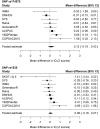Effect modification of FADS2 polymorphisms on the association between breastfeeding and intelligence: results from a collaborative meta-analysis
- PMID: 30541029
- PMCID: PMC6380307
- DOI: 10.1093/ije/dyy273
Effect modification of FADS2 polymorphisms on the association between breastfeeding and intelligence: results from a collaborative meta-analysis
Abstract
Background: Accumulating evidence suggests that breastfeeding benefits children's intelligence, possibly due to long-chain polyunsaturated fatty acids (LC-PUFAs) present in breast milk. Under a nutritional adequacy hypothesis, an interaction between breastfeeding and genetic variants associated with endogenous LC-PUFAs synthesis might be expected. However, the literature on this topic is controversial.
Methods: We investigated this gene × environment interaction through a collaborative effort. The primary analysis involved >12 000 individuals and used ever breastfeeding, FADS2 polymorphisms rs174575 and rs1535 coded assuming a recessive effect of the G allele, and intelligence quotient (IQ) in Z scores.
Results: There was no strong evidence of interaction, with pooled covariate-adjusted interaction coefficients (i.e. difference between genetic groups of the difference in IQ Z scores comparing ever with never breastfed individuals) of 0.12[(95% confidence interval (CI): -0.19; 0.43] and 0.06 (95% CI: -0.16; 0.27) for the rs174575 and rs1535 variants, respectively. Secondary analyses corroborated these results. In studies with ≥5.85 and <5.85 months of breastfeeding duration, pooled estimates for the rs174575 variant were 0.50 (95% CI: -0.06; 1.06) and 0.14 (95% CI: -0.10; 0.38), respectively, and 0.27 (95% CI: -0.28; 0.82) and -0.01 (95% CI: -0.19; 0.16) for the rs1535 variant.
Conclusions: Our findings did not support an interaction between ever breastfeeding and FADS2 polymorphisms. However, subgroup analysis suggested that breastfeeding may supply LC-PUFAs requirements for cognitive development if breastfeeding lasts for some (currently unknown) time. Future studies in large individual-level datasets would allow properly powered subgroup analyses and further improve our understanding on the breastfeeding × FADS2 interaction.
Keywords: Breastfeeding; FADS2; effect modification; fatty acids; intelligence; meta-analysis.
© The Author(s) 2018. Published by Oxford University Press on behalf of the International Epidemiological Association.
Figures


Similar articles
-
Effect modification of FADS2 polymorphisms on the association between breastfeeding and intelligence: protocol for a collaborative meta-analysis.BMJ Open. 2016 Jun 15;6(6):e010067. doi: 10.1136/bmjopen-2015-010067. BMJ Open. 2016. PMID: 27311901 Free PMC article.
-
FADS2 polymorphisms modify the effect of breastfeeding on child IQ.PLoS One. 2010 Jul 13;5(7):e11570. doi: 10.1371/journal.pone.0011570. PLoS One. 2010. PMID: 20644632 Free PMC article.
-
Cognitive function in adolescence: testing for interactions between breast-feeding and FADS2 polymorphisms.J Am Acad Child Adolesc Psychiatry. 2011 Jan;50(1):55-62.e4. doi: 10.1016/j.jaac.2010.10.010. Epub 2010 Dec 3. J Am Acad Child Adolesc Psychiatry. 2011. PMID: 21156270
-
Role of FADS1 and FADS2 polymorphisms in polyunsaturated fatty acid metabolism.Metabolism. 2010 Jul;59(7):993-9. doi: 10.1016/j.metabol.2009.10.022. Epub 2009 Dec 31. Metabolism. 2010. PMID: 20045144 Review.
-
Genetic variants in the metabolism of omega-6 and omega-3 fatty acids: their role in the determination of nutritional requirements and chronic disease risk.Exp Biol Med (Maywood). 2010 Jul;235(7):785-95. doi: 10.1258/ebm.2010.009298. Exp Biol Med (Maywood). 2010. PMID: 20558833 Review.
Cited by
-
Socioeconomic inequalities in cardiovascular disease: a causal perspective.Nat Rev Cardiol. 2024 Apr;21(4):238-249. doi: 10.1038/s41569-023-00941-8. Epub 2023 Oct 11. Nat Rev Cardiol. 2024. PMID: 37821646 Review.
-
Trends and inequalities in maternal and child health in a Brazilian city: methodology and sociodemographic description of four population-based birth cohort studies, 1982-2015.Int J Epidemiol. 2019 Apr 1;48(Suppl 1):i4-i15. doi: 10.1093/ije/dyy170. Int J Epidemiol. 2019. PMID: 30883654 Free PMC article.
-
FADS Genetic Variants in Taiwanese Modify Association of DHA Intake and Its Proportions in Human Milk.Nutrients. 2020 Feb 20;12(2):543. doi: 10.3390/nu12020543. Nutrients. 2020. PMID: 32093185 Free PMC article.
-
The impact of fatty acids biosynthesis on the risk of cardiovascular diseases in Europeans and East Asians: a Mendelian randomization study.Hum Mol Genet. 2022 Nov 28;31(23):4034-4054. doi: 10.1093/hmg/ddac153. Hum Mol Genet. 2022. PMID: 35796550 Free PMC article.
-
No Evidence of Interaction Between FADS2 Genotype and Breastfeeding on Cognitive or Other Traits in the UK Biobank.Behav Genet. 2025 Mar;55(2):86-102. doi: 10.1007/s10519-024-10210-0. Epub 2024 Dec 9. Behav Genet. 2025. PMID: 39652205 Free PMC article.
References
-
- Victora CG, Bahl R, Barros AJ. et al. Breastfeeding in the 21st century: epidemiology, mechanisms, and lifelong effect. Lancet 2016;387:475–90. - PubMed
-
- Horta BL, Loret de Mola C, Victora CG.. Breastfeeding and intelligence: a systematic review and meta-analysis. Acta Paediatr 2015;104:14–19. - PubMed
-
- Ritchie SJ. Publication bias in a recent meta-analysis on breastfeeding and IQ. Acta Paediatr 2017;106:345. - PubMed
-
- Dewey KG, Cohen RJ, Brown KH, Rivera LL.. Effects of exclusive breastfeeding for four versus six months on maternal nutritional status and infant motor development: results of two randomized trials in Honduras. J Nutr 2001;131:262–67. - PubMed

